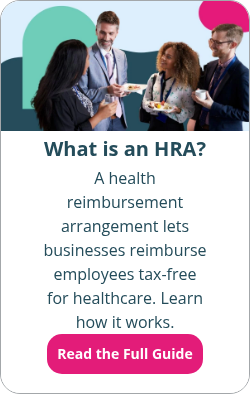What is a medical expense reimbursement plan (MERP)?
By Chase Charaba on January 24, 2024 at 10:15 AM
Several new health benefits plans have become available to employers in recent years that allow organizations to offer healthcare to their employees without purchasing a traditional group health insurance plan. One of these types of plans is a medical expense reimbursement plan (MERP), also known as a medical reimbursement account (MRA) or MERP plan.
With a MERP, organizations typically offer an allowance of tax-free money instead of a traditional benefit like group health insurance. Then, active employees purchase the healthcare products and services they want, potentially including an individual health insurance plan, and the organization reimburses them up to their allowance.
In this post, we'll explore how a MERP works and the various types of MERPs you may consider implementing for your organization.
Takeaways from this blog post:
- A MERP is an IRS-approved health plan where employers reimburse employees for out-of-pocket medical expenses tax-free.
- MERPs can be used alongside a group health insurance plan or offered as the primary health benefits plan.
- Employers set a monthly allowance amount, employees purchase healthcare products/services, submit proof of expense, and employers reimburse employees up to their allowance amount.
What is a MERP?
A MERP is any IRS-approved health plan or arrangement where an organization reimburses employees for out-of-pocket medical expenses incurred by employees or their dependents. All reimbursements are paid to the employee 100% tax-free if you administer it correctly.
You can use medical expense reimbursement plans alongside a group health insurance plan. Or, you can offer the medical reimbursement plan as the primary health benefits plan, usually as an alternative to a group health insurance plan.
A MERP isn't a section 125 plan (cafeteria plan) or flexible spending account (FSA). Instead, it's a section 105 plan, like a health reimbursement arrangement (HRA).
How do MERPs work?
MERPs are a way for employers to give tax-free money to their employees, which they can only use to pay for qualified medical expenses.
Typically, they follow a five-step process, which we’ve outlined below.
1. Employers set allowance amounts
With a MERP, employers set a monthly allowance amount for each employee. That allowance represents the maximum amount an employer will reimburse the employee for their monthly healthcare expenses.
2. Employees purchase healthcare items or services
Employees purchase the healthcare products and services they want with their own money. Depending on the type of MERP you offer, and the rules you establish, employees may also purchase individual health insurance policies.
3. Employees submit proof of the expense
After making their purchase, employees submit proof of their qualified expenses in the form of documentation. This document could be a receipt or explanation of benefits.
Proof of eligible expenses must include:
- The date the employee or dependent incurred the expense
- A description of the product or service
- The employee's name
- The cost of the item or service
4. Employers review employee documentation
Employers review employee documentation to ensure the expense is qualified for reimbursement and contains all necessary information. If any item is missing, they must inform the employee and allow them to provide additional information.
5. Employers reimburse employees
Finally, if everything is in order, the employer reimburses the employee up to their allowance amount.
To comply with federal regulations while administering a MERP, the employer must have section 105 plan documents that outline the terms of the MERP and administer the plan in a certain way. For these reasons, nearly all employers use a third-party or software provider to set up and administer the MERP.
What expenses can a MERP reimburse?
A MERP can reimburse any expense the IRS considers a qualified medical expense, including premiums for individual health insurance policies. You can also reimburse employees for expenses in the Coronavirus Aid, Relief, and Economic Security Act (CARES Act). Businesses may restrict the list of reimbursable eligible expenses in any way they choose.
Some of the most common reimbursable items include:
- Health insurance premiums
- Dental expenses
- Vision care expenses
- Hospital care
- Prescriptions
- Health plan deductibles
The items that you can reimburse vary by the type of plan offered. You can find the complete list in IRS Publication 502.
What types of MERPs are there?
The definition of a MERP is relatively broad, so several different types of employer-funded medical reimbursement plans fall within this umbrella term. Here are a few common ways employers use MERPs and what they're commonly called.
Stand-alone MERP or HRA
A stand-alone MERP, or stand-alone HRA, is a benefit employers offer as a way to reimburse active employees for individual (personal) health insurance policies. An employer offers the MERP instead of a group plan. This allows employers to offer great benefits without dealing with skyrocketing costs and constant insurance headaches.
The qualified small employer HRA (QSEHRA) is an example of a stand-alone MERP that the federal government specifically designed for employers with less than 50 full-time equivalent employees (FTEs).
With a QSEHRA, employers can reimburse employees for various healthcare products and services, including health insurance premiums.
MERPs with a group plan
Another way employers use MERPs is paired with a group health plan, usually a high deductible health plan (HDHP). With this type of MERP, employers usually raise the deductible on the current health plan and reimburse employees for the difference in the deductible. This effectively allows employers to self-insure a portion of their group insurance plan using pre-tax dollars, which leads to significant savings without any change in coverage.
MERPs paired with a group plan are commonly called group coverage HRAs (GCHRAs), integrated HRAs, deductible HRAs, traditional HRAs, or group HRAs.
MERPs with an individual plan
The individual coverage HRA (ICHRA) is another MERP type that can function as either a stand-alone benefit or as a separate option in an organization's health benefits program alongside group health insurance.
Here, employers can offer a group health insurance policy to one class of employees and an ICHRA to another class of employees who choose their own individual coverage. For example, you can offer full-time employees group health insurance while offering part-time employees the ICHRA. You just can't give the same class of employees a choice between the two.
MERPs for vision and dental
MERPs can allow employers to only reimburse certain types of expenses. If an employer wants to offer a vision or dental plan without buying expensive insurance, they can offer a MERP to their employees that only reimburses for vision and/or dental expenses.
Health stipends
Alternative health plans to group health insurance also include health stipends. Similar to MERPs, an employee health stipend allows you to reimburse your employees for their medical expenses. Because a health stipend isn't a formal benefit, you can choose to reimburse employees for more expenses than just those in IRS Publication 502.
Health stipends are taxable for both you and your employees. You must report any reimbursements or payments as income on your employees' W-2s.
While MERPs have tax advantages, there are benefits to offering a health stipend. You can offer stipends to 1099 contractors and international employees to help recruit and retain those workers. If you have any workers who receive advance premium tax credits (APTC), they can take advantage of both their credits and their stipend allowance.
However, there are disadvantages to a stipend. Stipends don't satisfy the Affordable Care Act's employer mandate for organizations with 50 or more FTEs. For these employers, offering a MERP like an HRA is a way to remain compliant with the law and avoid penalties.
Conclusion
A MERP is an excellent addition to your organization's benefits package as a way to offer greater financial assistance to employees. By allowing your employees to choose their own health insurance and use their MERP to get reimbursed for the expenses and healthcare services of their choice, you can help take care of their individual needs.
No matter your organization's size, budget, or insurance status, there is an option to meet every need. If you're ready to offer a MERP to your employees, PeopleKeep can help! Our personalized benefits software solutions make it easy to set up and manage HRAs in minutes each month.
Get in touch with a personalized benefits adviser to see how HRAs can help your organization!
This blog article was originally published on April 17, 2014. It was last updated on January 24, 2024.
Check out more resources
See these related articles

How does the QSEHRA work with Medicare?
Learn how the QSEHRA can assist with your Medicare supplemental premiums and maximize your healthcare benefits in this informative article.

Minimum contribution requirements: Group health insurance vs. HRAs
Confused about employer contribution rules for health insurance and HRAs? This article breaks down the minimum requirements to help you navigate your options.

Individual coverage HRAs (ICHRA) and Medicare
Learn how Individual Coverage HRAs (ICHRA) work with Medicare. Discover eligibility, rules, and how ICHRAs can benefit Medicare-eligible employees.



